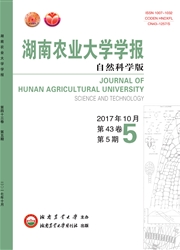

 中文摘要:
中文摘要:
采用0.66%促花剂、0.3%磷酸二氢钾、0.1%多效唑,通过喷施促花剂3次(T1)、喷施多效唑3次(T2)、喷施促花剂3次+环割+扭枝(r3)、喷施促花剂3次+环剥0.5cm(T41、喷施促花剂3次+环剥0.5cm+喷施磷酸二氢钾3次(T5)、滴水线处深沟断根+环剥0.5cm+喷施促花剂3次(T6)等调控技术来调控柠檬秋花果生产,以喷清水为对照(cK)。结果表明:各处理均使柠檬开花数、开花枝条数增加,除T1、T3外,其余处理柠檬开花期进程均呈现相同的变化趋势,表现为7月29日开花数较小,8月13日开花数达最大值,10月15151时开花数最小;各处理对柠檬单株果数、单株产量、单株优质套袋鲜果质量、单株加工果质量和总产量的影响较大,按指标数值排序,均表现为T6、T4、T5、T3、T1、T2、CK依次减小,其中,T6处理的产值(21.5万元/hm2)和利润(13.9万元/hm2)均最高,利润是对照的2.8倍。综合考虑,滴水线下深沟断根+环剥0.5cm+喷施促花剂3次可作为柠檬反季节生产调控技术应用于生产实际。
 英文摘要:
英文摘要:
Treatments spraying flower-promoting agent (T1), spraying paclobutrazol (T2), spraying flower-promoting agent + stick twisting and band girdling (T3), spraying flower-promoting agent + 0.5 cm wide-band girdling (T4), spraying flower-promoting agent and potassium dihydrogen phosphate + 0.5 cm wide-band girdling (TS), spraying flower-promoting agent +deep-ditch uprooting and 0.5 cm wide-band girdling (T6) and CK spraying water were designed to study the effects of different regulating technologies on flowering and yields of eureka lemon. Mass fractions of flower-promoting agent, potassium dihydrogen phosphate and paclobutrazol used in the treatments were 0.66%, 0.3%, 0.1%, respectively. The results indicated that the number of flowers and flowering branches increased in all treatments. The number of flowers presented similar tendencies in treatments except T1 and T3 during the whole process of flower opening, which was low on July 29, the highest on August 13 and the lowest on December 15. The different treatments showed big influence on the amount of fruits from single plant, yield, production of bagged fruit, production of processed fruit, in which T6 showed the highest influence, followed by T6, T4, TS, T3, T1, T2, CK (untreated). The yield and benefit of T6 was 215 thousand/hm2 and 139 thousand/hm2, respectively, which was the highest and 2.8 times higher compared to CK, therefore the technology in T6 could be applied to lemon production.
 同期刊论文项目
同期刊论文项目
 同项目期刊论文
同项目期刊论文
 期刊信息
期刊信息
